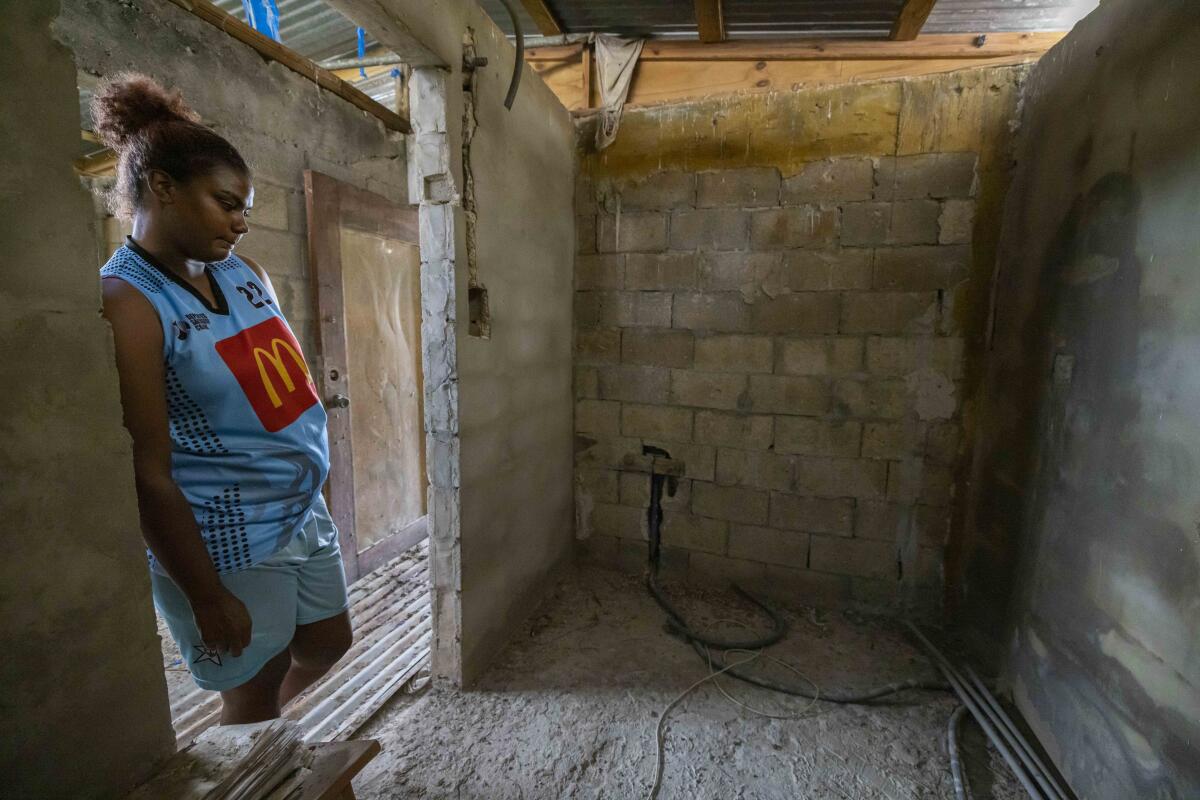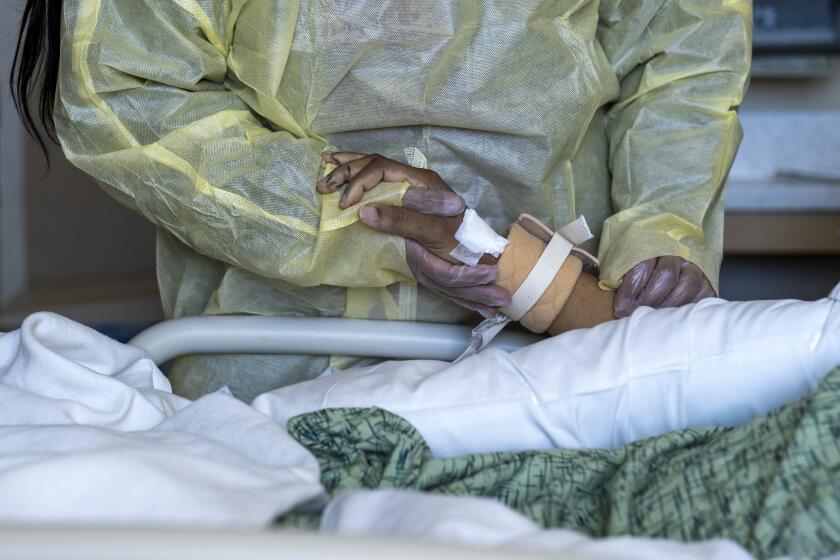5 years after Hurricane Maria, reconstruction drags on in Puerto Rico

- Share via
LOÍZA, Puerto Rico — Jetsabel Osorio Chévere looked up with a sad smile as she leaned against her battered home.
Nearly five years have gone by since Hurricane Maria struck Puerto Rico, and no one has offered her family a plastic tarp or zinc panels to replace the roof that the Category 4 storm ripped off the two-story home in an impoverished corner in the north coast town of Loiza.
“No one comes here to help,” the 19-year-old said.
It’s a familiar lament in a U.S. territory of 3.2 million people where thousands of homes, roads and recreational areas have yet to be fixed or rebuilt since Maria struck in September 2017. The government has completed only 21% of more than 5,500 official post-hurricane projects, and seven of the island’s 78 municipalities report that not a single project has begun. Only five municipalities report that half of the projects slated for their region have been completed, according to an Associated Press review of government data.
And with Hurricane Fiona forecast to hit Puerto Rico on Sunday with torrential rains, more than 3,600 homes still have a tattered blue tarp serving as a makeshift roof.
“That is unacceptable,” said Cristina Miranda, executive director of local nonprofit League of Cities. “Five years later, uncertainty still prevails.”
The death toll has fallen from past surges, but rates this summer still equate to COVID being one of the leading causes of death in the U.S.
Puerto Rico’s governor and Deanne Criswell, head of the U.S. Federal Emergency Management Agency who recently visited the island, stressed that post-hurricane work is underway, but many wonder how much longer it will take and worry another devastating storm will hit in the meantime.
Criswell said officials focused on recovery and emergency repairs for the first three years after Maria. Reconstruction has now started, she noted, but will take time because authorities want to ensure the structures being built are robust enough to withstand stronger hurricanes projected as a result of climate change.
“We recognize the concern that recovery may seem like it’s not moving fast enough five years later,” she said. “Hurricane Maria was a catastrophic event that caused damages that are really complex.”
The hurricane damaged or destroyed hundreds of thousands of homes and caused an estimated 2,975 deaths after razing the island’s power grid. Crews only recently started to rebuild the grid with more than $9 billion of federal funds. Island-wide blackouts and daily power outages persist, damaging appliances and forcing those with chronic health conditions to find temporary solutions to keep their medications cold.
The slow pace has frustrated many on an island emerging from the biggest municipal bankruptcy in U.S. history.
Some Puerto Ricans have opted to rebuild themselves instead of waiting for government help they feel will never come.
Osorio, the 19-year-old from Loiza, said her family bought a tarp and zinc panels out of their own pockets and set up a new roof over their second floor. But it leaks, so now she lives with her father and grandfather on the first floor.
Meanwhile, in the island’s central region, community leaders who accused the government of ignoring rural areas formed a nonprofit, vowing to never go through what they experienced after Maria. They’ve built their own well, opened a community center in an abandoned school and used their own equipment to repair a key road. They also opened a medical clinic in April and certified nearly 150 people in emergency response courses.
“That’s what we’re seeking, to not depend on anyone,” said Francisco Valentín with the Primary Health Services and Socioeconomic Development Corp. “We’ve had to organize ourselves because there’s no other option.”
Municipal officials also have grown tired of waiting for help.
In the southern coastal town of Peñuelas, Mayor Gregory Gonsález said he sought permission to hire special brigades to repair roads, ditches and other infrastructure, with work starting in mid-September.
It is one of five municipalities that has not seen a single post-hurricane project completed, with a pier, medical center, government office and a road still awaiting reconstruction. Gonsález said that few companies make bids because they lack employees, or they quote a price higher than that authorized by federal officials as inflation drives up the cost of materials.
It’s a frustration shared by Josian Santiago, mayor of the central mountain town of Comerío. He said it’s urgent that crews repair the main road that connects his town to the capital of San Juan because landslides are closing it down with increasing frequency. Tropical Storm Earl was blamed for causing eight landslides Sept. 6, just hours before it became a hurricane.
“It’s a terrible risk,” Santiago said, adding that engineers recently told him it could take two more years to repair. “Two years?! How much longer do we have to wait?!”
Reminders of how much time has passed since Hurricane Maria hit are scattered across Puerto Rico.
Faded red plastic tassels tied around wooden electrical posts that still lean as much as 60 degrees flapped in the wind as Tropical Storm Earl dumped heavy rain across the island in early September.
Norma López, a 56-year-old homemaker, has a post leaning just feet away from her balcony in Loiza, and it exasperates her every time she sees it.
“It’s still there. About to fall,” said López, who lost her roof to Hurricane Hugo in 1989 and again to Maria. “I’m here trying to survive.”
Sixty-five-year-old Virmisa Rivera, who lives nearby, said her roof leaks every time it rains, and the laminated walls near her bedroom are permanently soaked.
She said FEMA gave her $1,600 to rent a house while it repaired her roof, but no crews came by. Her boyfriend, who recently died, attempted to install zinc panels, but they don’t protect from heavy rain.
“My house is falling apart,” she said, adding that the government said it would move her to a new home in another neighborhood since it can’t repair hers because it’s in a flood zone.
But Rivera worries she will die if she moves: She takes 19 pills a day and uses an oxygen tank daily. Her family lives next door, which gives her security since she now lives alone.
Family also is the reason Osorio, the 19-year-old, would like to see a roof for the second floor. It’s where her mother raised her and her sister before dying. Osorio was 12, so her younger sister was sent to live with an aunt.
Plywood panels now cover the windows of the second floor that her mother built by hand with cinderblocks. It’s where she taught Osorio how to make candles and cloth wipes for babies that they used to sell, sitting side by side while Osorio talked about her school day.
“This is my mother’s,” Osorio said as she motioned to the second floor, “and that’s where I plan to live.”
More to Read
Sign up for Essential California
The most important California stories and recommendations in your inbox every morning.
You may occasionally receive promotional content from the Los Angeles Times.











